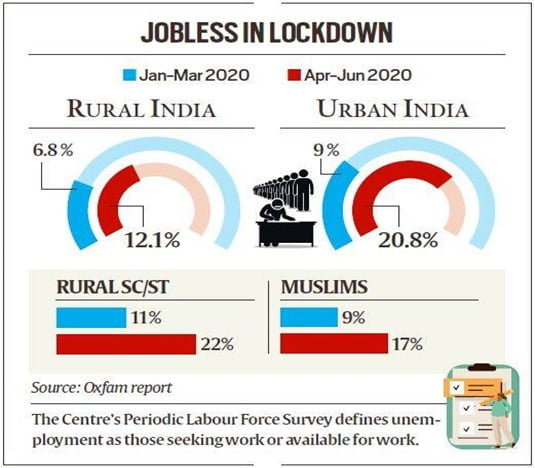Economics
In news: Discrimination in labour market
Sources of data:
- 61st round of National Sample Survey on employment-unemployment (2004-05)
- The Periodic Labour Force Survey in 2018-19 and 2019-20
- All-India Debt and Investment Survey by the Centre
- ‘India Discrimination Report’, compiled by the NGO Oxfam India from 2004-05 to 2019-20
- Data from the Union Ministry of Statistics and Programme Implementation
Meaning of Discrimination
- Discrimination in the labour market is when people with identical capabilities are treated differently because of their identity or social backgrounds
Meaning of Endowments
- It includes education, parental education and years of experience
- A) Discrimination against women
- Hardly any difference across religion or caste-based sub-groups, or the rural-urban divide.
- Gender discrimination in India is structural resulting in great disparities between earnings of men and women under ‘normal circumstances’
- Unemployed women have a high level of education and equal endowments as their male counterparts.
- Unemployment occurs because of prejudice; social biases such as women won’t be able to keep late hours or travel for work; and family and social pressure wherein women withdraw from the workforce or are not allowed to work.
- Overall discrimination in wages for women in this period increased from 67.2% in 2004-05 to 75.7% in 2019-20.
- B) Discrimination against SC and ST communities
- In rural India such discrimination is increasing in casual employment.
- However, there has been some decline due to endowments.
- For SC/ST employees, discrimination declined from 69.1% in 2004-5 to 34.6% in 2018-19 but increased to 39.3% in 2019-2020.
- C) Discrimination against Dalits and Adivasis and religious minorities like Muslims:
- Exists in terms of accessing jobs, livelihoods, and agricultural credits.
- For the Muslim community, the endowments are very low and limited access to regular salaried jobs. Therefore, Muslims are largely self-employed in family-owned businesses.
- They are also part of specialised jobs like cobbling or carpentry, where there is no (or little) competition. So, the discrimination against Muslims is low simply because the endowments are also low.
- Discrimination in employment for the Muslim community dropped from 31.5% in 2004-5 to 21.9% in 2018-19 to 3.7% in 2019-2020.
Data as per sources cited above:
| Labour Force Participation Rate (LFPR) for women | the proportion of working-age population that engages actively in labour market, either by working or looking for work | declined from 42.7% in 2004-05 to 25.1% in 2021 |
| In 2019-20, aged 15 and above that had regular salaried or self-employed jobs | Male – 60% | Female – 19% |
| For regular, self-employment in urban areas, the average earning | Male – Rs. 15,996 | Female – Rs. 6,626 |
| in 2019-20, Mean income for people with regular employment in urban areas | SC or ST communities
Rs 15,312 |
General – Rs 20,346 |
| Muslims in urban areas faced discrimination | in 2019-20 = 68.3% | in 2004-05= 59.3% |
| In 2019-20, people above 15 years of age in regular salaried jobs | Non- Muslims = 23.3% | Muslims= 15.6% |
| Oxfam report
regular, salaried in urban areas in 2019 |
non-Muslims = Rs 20,346 on average | Muslims = Rs 13,672 |
| Oxfam report
Self-employed in 2019
|
non-Muslims = Rs 15,878 | Muslims = Rs 11,421
(Despite over-representation of Muslims in urban self-employment) |

How to fight Discrimination
There are two possible strategies to reduce these biases: the first focuses on the victims of discrimination by empowering them to break free from the stereotypes that target them, while the second focuses on perpetrators.
- The first approach should be the heart of the policy.
- Frame initiatives in favour of equal opportunities allow identifying priority actions: enabling women to play on an equal footing with men through a better sharing of domestic and family tasks, which would be made possible by extending paternity leave; improving the employability of older people by preventing the risk of obsolescence of their skills; improving the educational and professional integration of people with a vulnerable and migrant
Regarding the second approach, there has a wide range of legislation to combat discrimination.
- The actions against the perpetrators of discrimination are rarely brought to court.
- Thus, making the threat of legal sanctions credible is critical: this requires a better knowledge of the legal framework and the possible remedies in case of discrimination in the labour market, and the presence of trained interlocutors to assist employees in their efforts.
Oxfam
- It is founded and led by Oxfam International (British founded confederation) in 1942 consisting of 21 independent charitable organizations
- Focusing on the alleviation of global poverty
- Oxfam India was one of the organisations that faced an Income Tax survey recently. Oxfam maintained that it was compliant with domestic laws.
National Statistical Office (NSO):
- Formed with the merger of NSSO and CSO.
- The Statistics Wing of Ministry of Statistics and Programme Implementation (MOSPI)
- Recommended by Rangarajan Commission
- To implement and maintain statistical standards and coordinate statistical activities of Central and State agencies.
- It consists of 3 directors.
Source: Indian Express
Previous Year Questions
Q.1) In India, which one of the following compiles information on industrial disputes, closures, retrenchments and lay-offs in factories employing workers?
- Central Statistics Office
- Department for Promotion of Industry and Internal Trade
- Labour Bureau
- National Technical Manpower Information System











